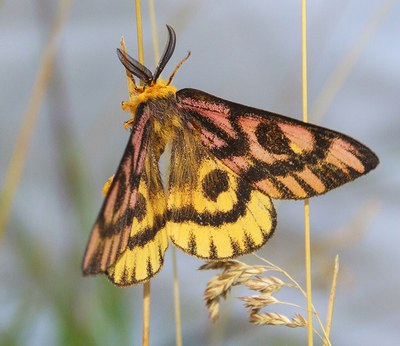It’s National Moth Week! Although moths are often overlooked for their more popular cousin the butterfly, moths are actually quite amazing creatures.
Moths, like butterflies, are in the scientific order Lepidoptera meaning “scaly winged.” Within this order, moth species outnumber butterfly species by 19 to 1. There are about 11,000 – 14,000 species of moths in the U.S. To put that in perspective, that is more than all the bird and mammal species in North America combined! Despite this diversity (or perhaps due to its vastness), moths are relatively unstudied insects. Here are some things we do know about moths:
Cool facts about moths:
- Moths and butterflies win the gold medal for the most awesome life cycle. Caterpillars form a cocoon (called a chrysalids for butterflies) where the insect undergoes complete metamorphosis and emerges with wings!
- Some adult moths don’t eat! Many of the larger moth species such as luna and atlas moths don’t have a proboscis. They only live for about a week with the sole purpose of reproduction.
- Not all moths are nocturnal. Many moths are diurnal (active at day) or crepuscular (active at dawn or dusk).
- The largest moth in the world, the atlas moth, has a wingspan of up to 12 inches!
- Some moths can detect the echolocation of bats and produce similar clicking sounds that interfere with the bat’s ability to locate its prey.
- Moths are important pollinators. The yucca plant is pollinated exclusively by the yucca moth.
How to tell a moth from a butterfly:
- Male moths tend to have feathery antennae while females tend to have thin filament antennae. The feathering on male antennae increases the surface area and makes them more receptive to detecting female pheromones (sex hormones). Butterfly antennae are thin with club-shaped tips.
- Moths, unlike butterflies, have a frenulum which joins the forewing to the hind wing so the wings move together during flight.
- When resting, moths tend to cover the hindwing with their forewing, while butterflies hold their wings together above their body.
Three moth species to spot in Central Oregon:
- Elegant Day Moth (sheep moth). As the name suggests, these moths are diurnal, meaning they are active during the day. Next time you are at the Metolius Preserve keep an eye out for the pink, yellow, and black wings of these fuzzy moths.
- Pandora Moth. If you were wondering about all the caterpillars that were out in June, they were likely pandora moths. Pandora moths are the culprit for widespread defoliation of ponderosa forests during outbreak years. Pandora moths have a two-year life cycle, so the caterpillars and moths are out on alternating years.
- Ceanothus Silk Moth. The caterpillars of the ceanothus silk moth look like a creature straight out of a sci-fi movie. The plump green bodies have true legs and spines along the back. Adults have a wingspan of about 10 cm and are reddish-brown in color. Adults are nocturnal and fly in the spring.
Learn more
- Learn more about moth's cousins, butterflies
- The Xerces Society has information on Gardening for Moths
- Moth identification guide for the Pacific Northwest
Sources
- Live Science, 7 Things You Didn't Know About Moths, but Should
- The National Wildlife Federation, Working the Night Shift
- Lepidoptera of the Pacific Northwest: Caterpillars and Adults. Jeffery C. Miller and Paul C. Hammond. 2003.


